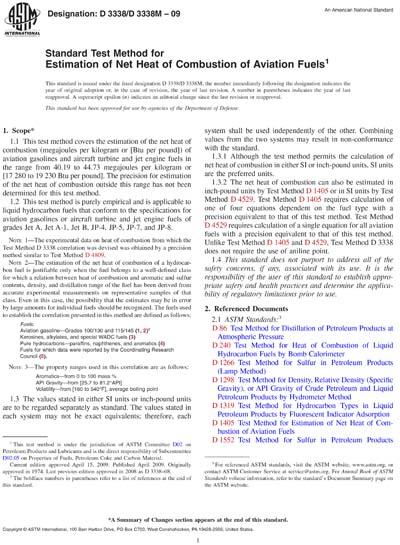Historical
ASTM D3338/D3338M-09
Standard Test Method for Estimation of Net Heat of Combustion of Aviation Fuels
1.1 This test method covers the estimation of the net heat of combustion (megajoules per kilogram or [Btu per pound]) of aviation gasolines and aircraft turbine and jet engine fuels in the range from 40.19 to 44.73 megajoules per kilogram or [17 280 to 19 230 Btu per pound]. The precision for estimation of the net heat of combustion outside this range has not been determined for this test method.
1.2 This test method is purely empirical and is applicable to liquid hydrocarbon fuels that conform to the specifications for aviation gasolines or aircraft turbine and jet engine fuels of grades Jet A, Jet A-1, Jet B, JP-4, JP-5, JP-7, and JP-8.
Note 1—The experimental data on heat of combustion from which the Test Method D 3338 correlation was devised was obtained by a precision method similar to Test Method D 4809
Note 2—The estimation of the net heat of combustion of a hydrocarbon fuel is justifiable only when the fuel belongs to a well-defined class for which a relation between heat of combustion and aromatic and sulfur contents, density, and distillation range of the fuel has been derived from accurate experimental measurements on representative samples of that class. Even in this case, the possibility that the estimates may be in error by large amounts for individual fuels should be recognized. The fuels used to establish the correlation presented in this method are defined as follows:
| Fuels: |
| Aviation gasoline—Grades 100/130 and 115/145 (1, 2) |
| Kerosines, alkylates, and special WADC fuels (3) |
| Pure hydrocarbons—paraffins, naphthenes, and aromatics (4) |
| Fuels for which data were reported by the Coordinating Research Council (5). |
Note 3—The property ranges used in this correlation are as follows:
| Aromatics—from 0 to 100 mass % |
| API Gravity—from [25.7 to 81.2°API] |
| Volatility—from [160 to 540°F], average boiling point |
1.3 The values stated in either SI units or inch-pound units are to be regarded separately as standard. The values stated in each system may not be exact equivalents; therefore, each system shall be used independently of the other. Combining values from the two systems may result in non-conformance with the standard.
1.3.1 Although the test method permits the calculation of net heat of combustion in either SI or inch-pound units, SI units are the preferred units.
1.3.2 The net heat of combustion can also be estimated in inch-pound units by Test Method D 1405
1.4 This standard does not purport to address all of the safety concerns, if any, associated with its use. It is the responsibility of the user of this standard to establish appropriate safety and health practices and determine the applicability of regulatory limitations prior to use.
ASTM International [astm]

